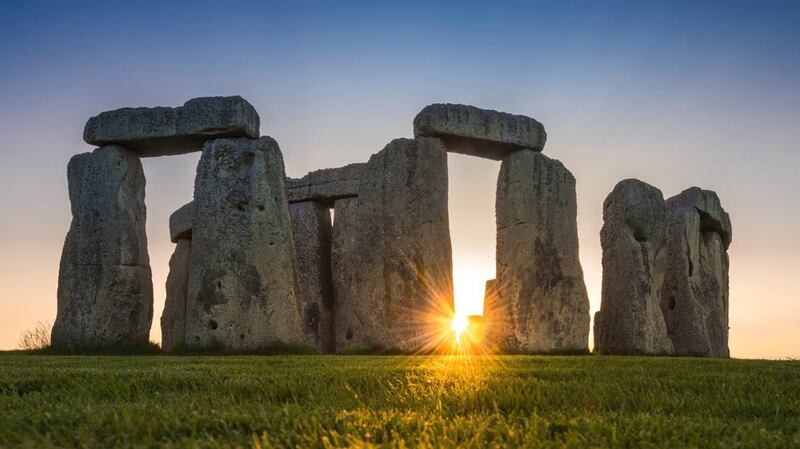Revellers are set to flock to Britain's ancient Stonehenge on Tuesday evening to witness the summer solstice on June 21.
Every year, Salisbury Plain in England's Wiltshire throngs with pagans, druids, mystics and partygoers who gather to watch the sunrise on what is officially the first day of summer.
Home to what are perhaps the world's most famous monolithic stones, the site welcomes thousands of people annually for the midsummer festival celebrations.
And this year will be no exception, with the age-old relics at Britain’s most celebrated archaeological site ready to put on a show.
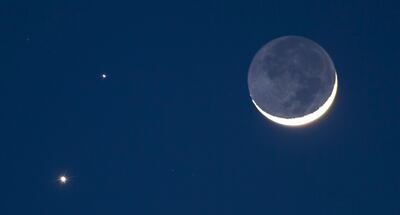
In fact, those attending this year could be in for a special treat as Venus, Mars and the crescent moon are set to align at twilight in a rare celestial gathering. The trio are also likely to be visible again after sunset on Wednesday, the longest day of the year.
Here's everything you need to know about this year's summer solstice gathering at Stonehenge, which celebrates the longest day and the shortest night in the Northern Hemisphere.
What is Stonehenge?
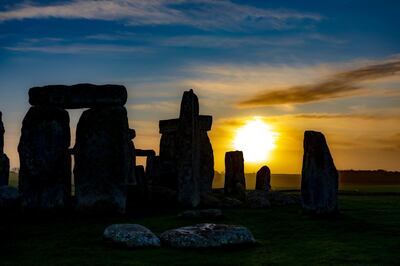
If you've never heard of Stonehenge before, the site is bound to be a mystery. Even if you're familiar with the ancient stones, the intrigue remains. Decidedly otherworldly, Stonehenge is more than 5,000 years old and was built as a temple – a place of ceremony, burial and celebration.
“It's likely people gathered at Stonehenge at both midsummer and midwinter solstices to conduct rituals and ceremonies,” said a representative for English Heritage, the charity that manages the historic site, on Instagram.
“We know it must have been important for them to align their monument with the sky, but we may never know why.”
An important place that means different things to different people, Stonehenge is also an impressive feat of engineering.
“The Stone Circle is a masterpiece of engineering, and building it would have taken huge effort from hundreds of well-organised people using only simple tools and technologies,” explains Heather Sebire, curator for English Heritage.
What is the summer solstice?
The word solstice comes from the Latin word for sun (sol) and to stand (sistere). It's the time of year when the position of the rising or setting sun stands still in its movement along the horizon.
Stonehenge is dramatic any day of the year, but watching the sun rise over the ancient grounds at solstice is a memorable moment.
In the ancient world, there was nothing more significant than the changing of the seasons and summer solstice marked the start of summer, and the death of spring, which is why it held such prominence.

Even without this reliance on nature, the event is a visual feast and marks the longest day of the year north of the equator.
“At dawn on summer solstice, rays of sun are channelled into the centre of the monument through a gap between two stones of the outer circle and through the opening to the central horseshoe of trilithons,” says Sebire.
A trilithon is a structure of two large vertical stones supporting a third stone set horizontally across the top.
“Originally, the dawn light would have struck the Altar Stone which originally stood before the horseshoes tallest pair but which now lies beneath the fallen pillar of the central trilithon.”
How to watch the 2023 summer solstice at Stonehenge
Stonehenge will close to tourism during summer solstice and instead open free of charge to those looking to celebrate solstice. Revellers will be welcomed to the ancient site on Tuesday evening, with celebrations taking place throughout the evening until daybreak on Wednesday.
English Heritage will live-stream the event from Stonehenge across its social media pages so that people around the world can tune in to catch the celestial moment. There are two streams, one that starts at 8.30pm (UK time) on Tuesday and a second that will run from 4am (UK time) on Wednesday.
Visitors keen to experience the skies above Stonehenge and learn more about the solar alignment at the famous stone circle, can also visit Skyscape for live-feed video of this ancient site on any day of the year.
Why do people dress up for summer solstice at Stonehenge?
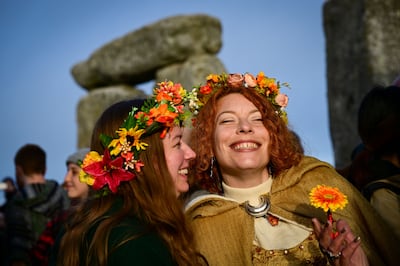
The solstice is a time of festivity for many people, which is why many of those attending Stonehenge for the event wear brightly coloured clothes and garlands.
Gold, yellow and red clothes that match the energy of the rising sun are popular, as are flowers such as lavender and sunflowers, which have long been associated with Midsummer.
Given the vast amount of history and ongoing mystery surrounding ancient Stonehenge, there is no one answer on what people should wear when visiting the site.
What happens in the UAE during summer solstice?
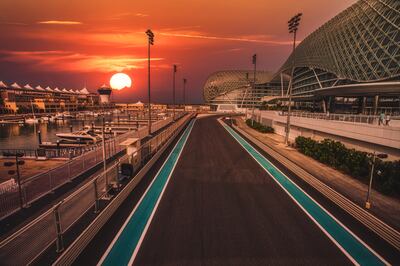
The summer solstice officially marks the beginning of the season in the Northern Hemisphere. It's also the longest day of the year and the shortest night for many countries.
Following the event, daylight hours slowly begin to decrease until the Autumnal Equinox in late September which is when there is typically an equal amount of daylight and darkness.
In the UK on Thursday, there will be about 17 hours of daylight – which is about nine hours more daylight than the country typically sees during the winter solstice in December. Sunset is scheduled for around 9.30pm on Thursday in the UK and this will gradually get earlier post solstice.
The further from the North Pole countries are, the less noticeable the difference is, so in the UAE, the seasonal changes are not as obvious.
Daylight hours in the UAE have increased marginally ahead of the solstice, with about 13 hours of sunshine predicted on Wednesday and sunset taking place at 7.13pm. This will also begin to decrease post solstice and by late September, there will only be 12 hours of sunshine per day with sunsets happening earlier at around 6pm.
